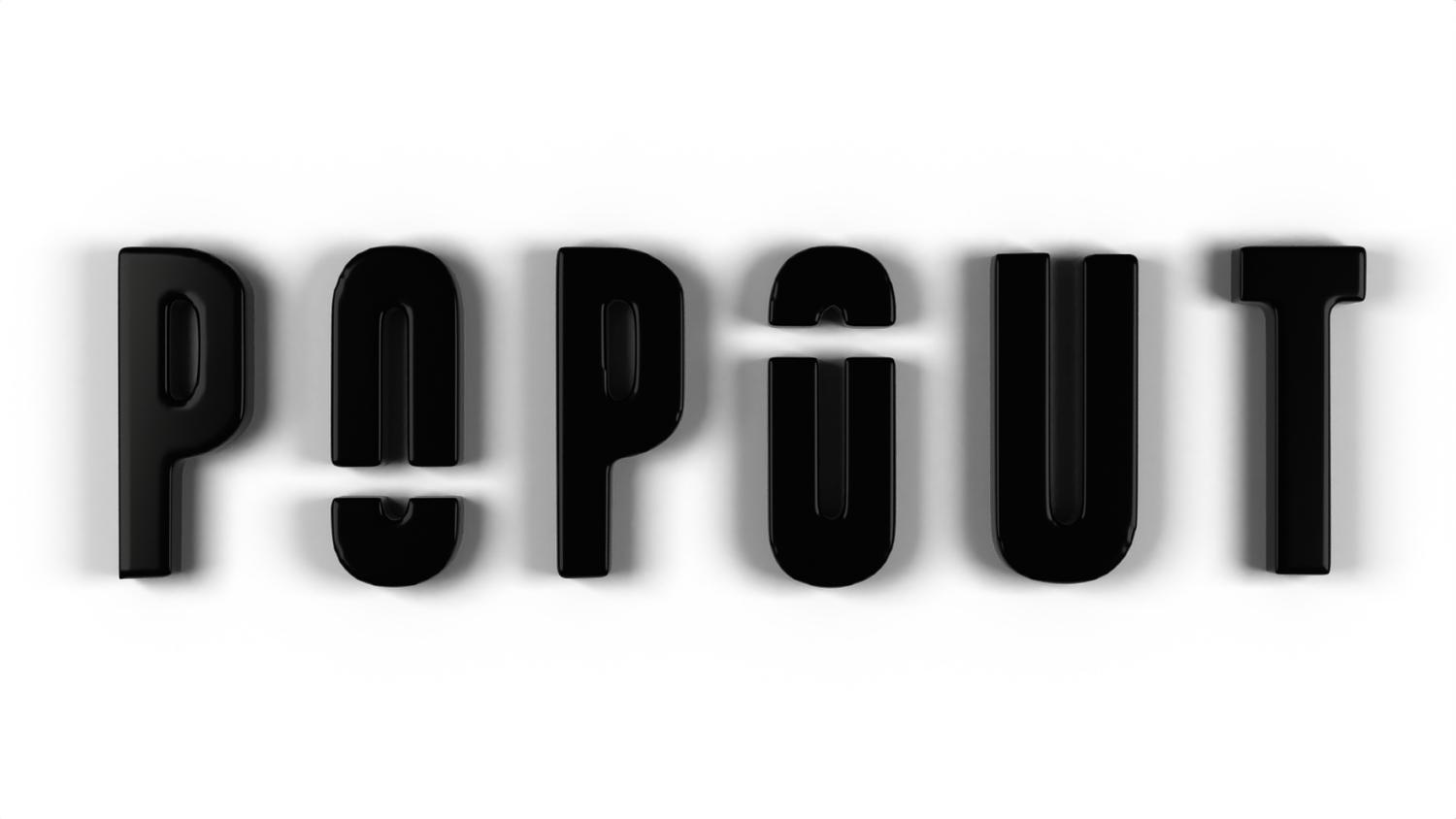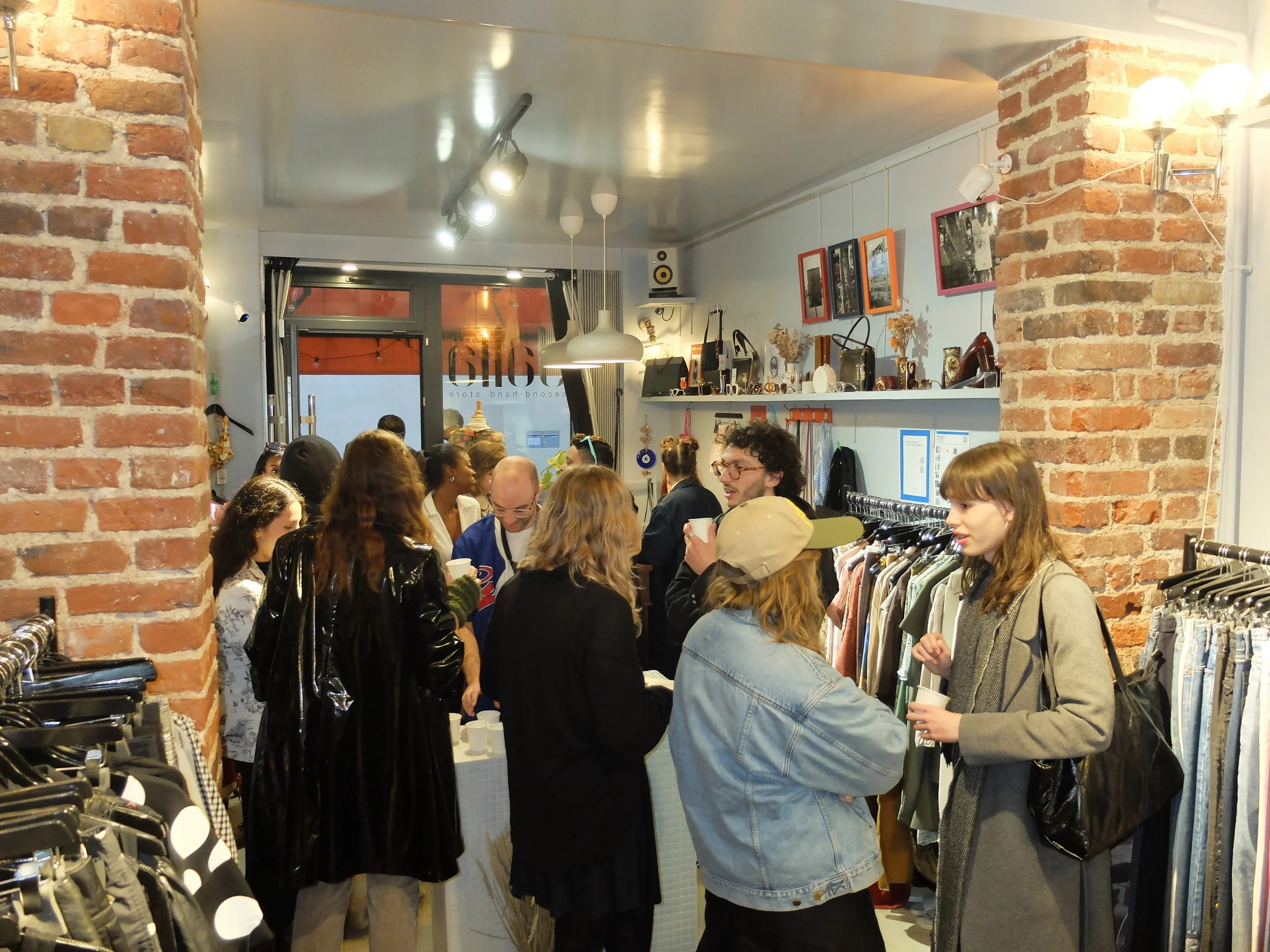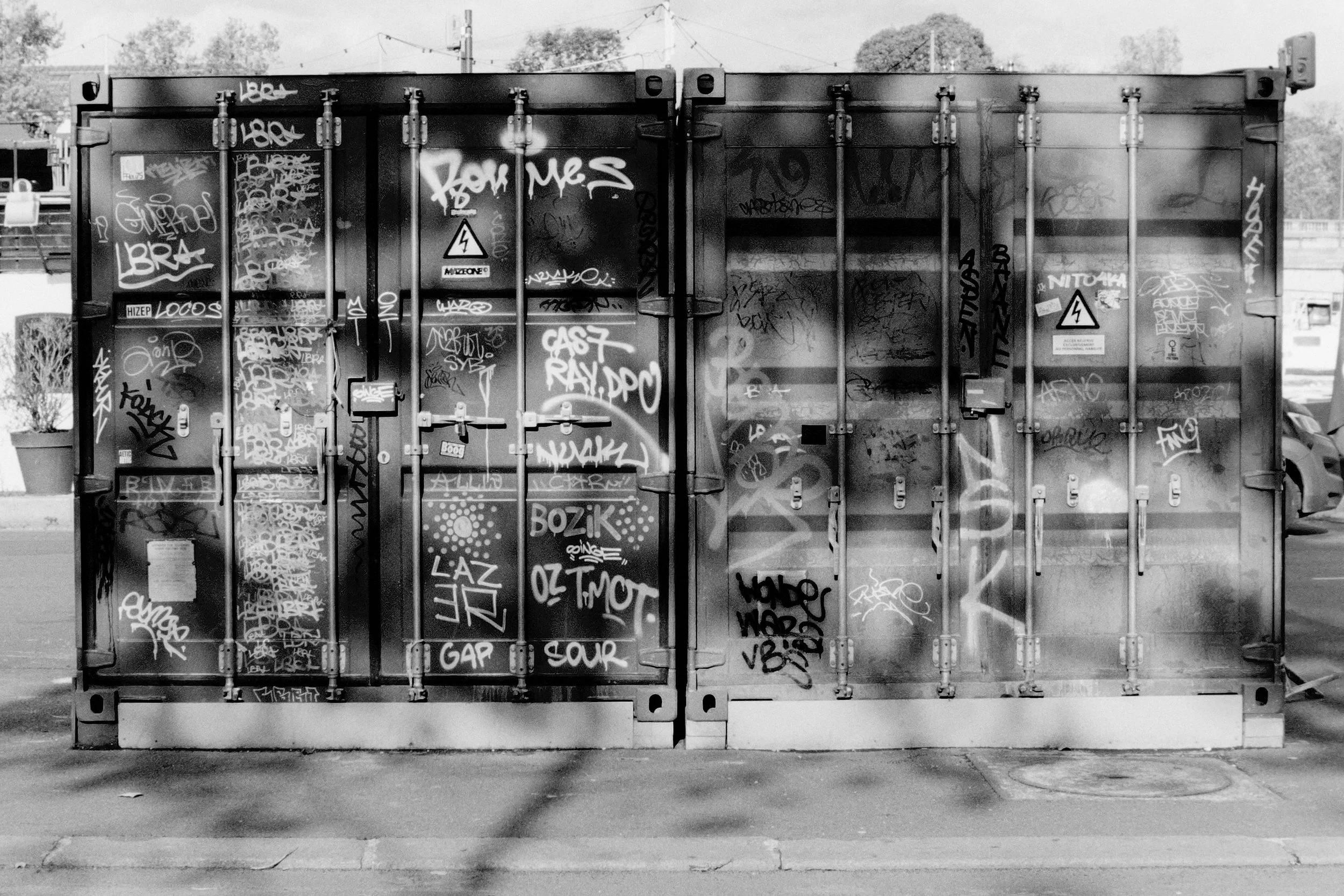Embracing the Observer: Aris Theotokatos and His Unseen Paris
From May 2nd to June 5th, Yälla Store Paris 18th transformed into a window to the unseen—a truly evocative display of the often-overlooked elements of Parisian streets. Through the lens of Greek-American photographer Aris Theotokatos, visitors were encouraged to discover a different, thought-provoking perspective on the city and its public spaces. This ongoing monthly collaboration between POPOUT and Yälla Store Paris aims to make art more accessible to the everyday shopper while simultaneously showcasing and empowering emerging Parisian creatives. For this installment, they featured Aris, whose personal and artistic evolution is as compelling as the images he captures. The POPOUT community and I sat down with the photographer to discuss the showcase as well as his personal and artistic trajectory.
Event images captured by photographer Rebecca Rowe
From Performer to Observer
Initially drawn to creative expression through acting and poetry slam, Aris found himself increasingly disillusioned with the performative aspects of these arts, leading to what he referred to as the ‘catastrophe.’ “The catastrophe came like five or six years into [poetry slam] when it came to a point where I was reliving my trauma, or re-traumatizing myself just to get a poem out. You have to get yourself into a certain mental space to perform it and have it be a genuine performance. It put me in a really bad space where I thought I was doing it for the wrong reasons,” he recalled.
Upon realizing his distaste for poetry slam (more specifically, its application of an ‘Olympic-style’ grading system to one’s personal trauma), Aris drew on his community to pivot towards a new creative direction— photography. “Through poetry slam I was able to meet tons of artists. In Chicago, the poetry slam scene is very intertwined with the rap scene,” he explained. “I started to get invited to a lot of shows, and I was thinking to myself, ‘You know, I might as well start taking photos while I’m here, to document it.’” This shift allowed Aris to fully embrace his new sense of creative purpose. “For me, learning a whole new artistic process was exciting. I was re-energized. I was sharing my own stories with poetry slam, now I got to transition into being someone who was observing and helping other artists shape their stories and their identities.”
Throughout this artistic transition, Aris’ approach to concert photography was heavily influenced by the Nigerian photographer and documentarian Chi Modu (1967-2021), who is widely recognized from his tenure at The Source Magazine. “Growing up, The Source was my favorite magazine. I was really into hip-hop, really into rap. I loved his photographs. He has iconic photos of Tupac, Biggie, Snoop Dogg. [Modu’s work at The Source] was what I was looking at when I started to take concert photos. He interacted with artists and he was basically their friend, so that was also how I tried to operate.”
As Aris gained more experience photographing local artists in Chicago, he came to a career-defining realization: “Eventually, I learned that I just loved the photographic process. I love documenting things.”
After moving to Paris from Chicago in 2018, Aris decided to formally study photography at Paris College of Art. Despite not particularly enjoying his time at the university, largely due to the authoritative critique process, the photographer expresses a deep gratitude for the experience and the lessons it taught him. “It’s this notion of getting a critique, then having to justify the choices that you make. I’m very anti-authority, so it’s hard for me to be in a situation where someone’s telling me what to do,” he noted.
Moreover, the rigidly-structured environment and constant urging by his professors to continually experiment with his artistic identity sometimes felt stifling to Aris, who expressed, “I’ve gone through the part of my life where I experimented with my identity and, ‘Who am I?’. I know that stuff.”
Despite his general ambivalence towards the academic structure of PCA, Aris does note two revelatory pieces of feedback he received during his studies which aided him in refining his photographic style and philosophy. The first was during his senior year, when a faculty member critiquing his work offered an unexpected comment. “She takes off her glasses, she looks me right in the eye, and she’s like, ‘You take photos like my grandmother.’” In the moment, Aris jokingly thought to himself, “Thank you, your grandmother must be cold as fuck.” Upon reflection, however, he realized the deeper sentiment behind her words. “What she was really trying to say was that I wasn’t exciting her with my photos, that I was taking very traditional, straight-forward photos.”
This critique helped him reconcile his approach, understanding that, “Actually, yea, I would love for your grandmother to buy one of my photos. That’s my target market now.” The second memorable piece of feedback received by Aris came during a summer course, where a teenage study-abroad student from the U.S. was tasked with giving his work a mock-critique. “After thirty seconds of her studying and looking at everything, she turns and looks at me and she’s like, ‘I don’t know why, but I like your photos.’ Then she just walks away. That was all she said,” explained the photographer. “That was cool for me to hear, even though I think the teacher was like, ‘That’s it? That’s all you’re gonna give him?’ But I was like, ‘You know what, that’s all I need to hear.’ That makes me know that I’m doing what I’m aiming to do, which is making an image that’s easily understood but that can also be provocative.”
Shaped by these pivotal experiences, Aris’ photography showcase at Yälla Store Paris masterfully illustrated the development of his distinct artistic voice.
The Showcase at Yälla Store Paris
Aris’ showcase at Yälla Store Paris focused on the ephemeral question of art in public—and publicly-facing—Parisian spaces (think store-fronts, building facades, lamp posts, and mailboxes). The series, consisting of black-and-white photographs set in contrasting frames of burnt yellow, olive green, and dark raspberry magenta, for example, invited contemplation on the boundaries of art, ownership, and space, questioning who is allowed to create art in these shared environments.
“Graffiti is built on this concept of wanting to be seen but not wanting to be known. They’re all aliases, tags are aliases. No one ever writes their full name on a building. What always struck me was the contrast of what’s private property and what’s public property,” Aris explained. “What makes something private property is really a signature on the deed, right? Your actual signature that’s on your birth certificate. It’s your name on a deed that gives you ownership over something.”
image from the ‘In your Heart & On Your Mind’ series by Aris Theotokatos
Indeed, Aris’ exploration of the differentiation between authorized public art—the intentionally aesthetic design of city architecture and infrastructure—and unauthorized public art—the graffiti, posters, and stickers which cover these surfaces—stood as one of the most poignant aspects of the series. By inviting contemplation on this topic solely through the visual language of photography, Aris fostered a passive yet powerful form of cultural criticism, encouraging observers to independently question and explore these phenomena without overt direction. Moreover, by capturing and emphasizing these fleeting subcultural expressions, the showcase delved into the deeper philosophical questions of what constitutes art and who has the right to create it. “People who are nameless, or maybe they feel voiceless, they write their alias somewhere on a wall and they sort of reclaim a space. It’s their way of reclaiming public property so to speak,” commented the photographer.
Aris’ approach to photography is defined by a duality between the initial spontaneous act of capturing images and the subsequent rumination of the meaning attached to the printed, framed object. Reflecting on his influences, Aris contrasted his fast-paced, intuitive approach to capturing photos with that of the 20th-century German photographers Bernd and Hilla Becher (1931-2007, 1934-2015), who would notably spend sometimes an entire day waiting for the perfect conditions to capture their industrial scenes. “Who has that time now?” he quipped. “When I see a potential photo, I take anywhere between thirty seconds to five minutes to compose and take the photo, but that’s about it.” This preliminary immediacy, however, lays the groundwork for the meticulous contemplation which comes after the taking of an image.
It is this contemplative secondary act that truly highlights the technical and thoughtful nature of Aris’ art. When ascribing meaning to his images, the photographer utilizes a meticulous yet unconventional interpretive framework involving three interlocking frames. The first frame, according to Aris, is the camera viewfinder, where the outside environment is pared down to a single square or rectangle scene. The second are the physical frames, which encase the printed scenes and impart upon each of them a sense of physical individuality. The third, most abstract frame, is the conceptual frame surrounding a series in its totality; a ‘meta-frame’ of sorts which provides answers to questions such as “How are you framing your project for people? How are you framing your concept?”
Aris deeply links this layered and conscientious methodology to his background in slam poetry. “Every line in a poem needs to be able to stand on its own. I call that the integrity of a line,” he explained. “Can I take a line out? If I write it on a wall independently, can it still impact someone? And I look at my photos the same way. I need each photo in a series to be able to stand on its own and have integrity on its own rather than only making sense within a series. So, for me, those color frames make everything a unique object.”
image from the ‘In your Heart & On Your Mind’ series by Aris Theotokatos
Reflecting further on the philosophical underpinning of his showcase, Aris explained, “What I’m aiming to convey is basically that there’s really no such thing as truth. I look at my work, especially this series, as being part socio-historical document, part myth. The myth comes from my perspective, my composition, and also the addition of the color frames with the black and white photograph. I wanted to kind of blend these two things [socio-historical documentation and interpretive myth-making], but do it in a way that wasn’t overly complex and wasn’t going to be condescending.”
In blending these elements, Aris invited attendees to contemplate the fluid boundaries between truth and myth, anonymity and ownership, the public and the private, encouraging a deeper understanding of art’s role in communal city spaces.
Written by Chris Turner














